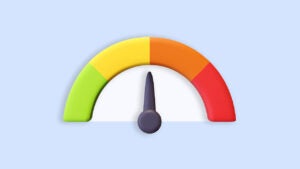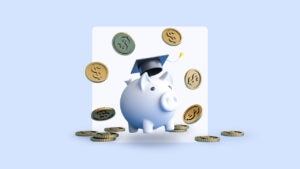What is a federal Direct Loan?

Direct Loans are federal student loans issued by the U.S. Department of Education. A great starting point for most borrowers, these loans offer both low interest rates and generous borrower protections. Federal Direct Loans are available for both undergraduate and graduate borrowers and may be used to cover various educational expenses. There are four types of Direct Loans, each with eligibility requirements and interest rates.
How a federal Direct Loan works
To see whether you’re eligible for Direct Loans, submit the Free Application for Federal Student Aid (FAFSA), which typically opens on Oct. 1 every year. Once your school reviews your FAFSA, it determines which types of aid you’re eligible for based on your expected family contribution, financial need and other factors. You’ll see the offer in your award letter if you’re eligible for federal Direct Loans.
You can take some or all of the Direct Loan aid offered. You’ll need to complete entrance counseling, which reminds you of your responsibility upon accepting federal Direct Loans. Borrowers are also required to sign a Master Promissory Note, which is a document that outlines the details of your loan, including important information about repayment.
At this point, the Department of Education will disburse the funds directly to your school. The school will apply funds toward tuition, fees and other costs you owe. If there are any remaining loan funds, the school will disburse it to you or your parent if they received parent PLUS loans.
Types of Direct Loans
There are four types of Direct Loans, each with a loan cap and interest rate. Which one you’ll get depends on your financial need and academic level.
Direct Subsidized Loan
A Direct Subsidized Loan is available only to undergraduate students who’ve demonstrated financial need. It offers the biggest advantage for student borrowers since the federal government subsidizes interest during certain periods. This means that the Department of Education pays for accruing interest during the following scenarios:
- When the student is enrolled at least half time in school.
- During the first six months after the student graduates or leaves school.
- When the loan is in deferment.
By default, Direct Subsidized Loans are placed on a Standard Repayment Plan. This plan divides your federal student loans into fixed, equal payments over a 10-year term. But you can change your repayment plan for free at any time.
Currently, the interest rate on Direct Subsidized Loans is 6.39 percent, and a small loan fee of 1.057 percent of your loan amount will be deducted before funds are disbursed.
Direct Unsubsidized Loan
Eligible undergraduate, graduate and professional students have access to Direct Unsubsidized Loans. Direct Unsubsidized Loans are like Direct Subsidized Loans, but they don’t subsidize interest.
Instead, interest accrues immediately, and students are responsible for any interest as soon as funds are disbursed. However, while a student is enrolled at least half time in school, or in deferment or forbearance, they can choose to not make interest payments. This will cause the accrued interest to capitalize — in other words, be added to the total loan balance.
The interest rate on Direct Unsubsidized Loans is 6.39 percent for undergraduate borrowers and 7.94 percent for graduate and professional borrowers. An origination fee of 1.057 percent applies before loan disbursal.
Direct PLUS Loan
A Direct PLUS Loan is available to eligible graduate or professional students or eligible parents of an undergraduate student. Depending on the borrower, it’s commonly referred to as either a “grad PLUS loan” or a “parent PLUS loan.”
Direct PLUS Loans are not need-based. They require a credit check, and you must meet the Department of Education’s borrower requirements to be approved. However, applicants who don’t have strong credit might still be awarded funding if they can provide an endorser for the loan. An endorser is similar to a co-signer since they guarantee they’ll repay the loan if you can’t. You might also be awarded a PLUS Loan if you have proof of an extenuating circumstance that led to your adverse credit.
The interest rate on grad PLUS and parent PLUS loans is 8.94 percent, and they have an origination fee equal to 4.228 percent of the total loan amount.
Direct Consolidation Loan
Borrowers who’ve taken out multiple federal student loans can simplify their repayment experience through a Direct Consolidation Loan. This type of loan combines all your eligible outstanding federal loans into one loan, with one monthly payment and one fixed interest rate. To consolidate your loans, you’ll need to be in repayment already.
It’s free to apply for a Direct Consolidation Loan, and you can extend your loan term up to 30 years. This reduces your monthly payment, but it also means that it’ll take you longer to pay off your loans, meaning you’ll pay more in interest over the total life of the loan.
There are other downsides to a Direct Consolidation Loan. Your fixed interest rate is determined based on the weighted average of all loans being consolidated, so you won’t necessarily save on interest costs using this method. Consolidation also adds any outstanding interest on your original loans to the new principal balance.
Finally, if you’re working toward Public Service Loan Forgiveness, taking out a Direct Consolidation Loan will erase any progress you’ve made toward the 120 payments required for forgiveness. This means that you’ll have to start the process all over again.
How to get a federal Direct Loan
Direct Loans are the best choice for many student loan borrowers. To get started, follow these steps:
- Complete the FAFSA. The FAFSA uses tax returns, pay stubs and other official documents to determine your expected family contribution and what financial aid you qualify for.
- Finish requirements for acceptance. Since taking out a loan requires entrance counseling, you’ll need to finish this before you receive your loans.
- Take only what you need. Just because you could get approved for the full loan amount doesn’t mean you should take it. Only borrow what you need for school, since you’ll eventually have to pay it back with interest.
- Sign your Master Promissory Note. Your Master Promissory Note is essentially your lender agreement; it outlines your obligations to repay the loans and the consequences should you fail to do so. You can’t get your loan without signing this.
- Your school gets the funds. Once you’ve completed the paperwork, the Department of Education will disburse the funds directly to your school. If there’s anything left over, it’ll go to you (or your parent, if they took out the loan).
How much money students can borrow in a federal Direct Loan
Federal Direct Loan borrowing limits vary depending on the Direct Loan type and student status.
- Dependent undergraduate students may borrow up to $31,000 total in Direct Loans, $23,000 of which may be subsidized.
- Independent undergraduate students may borrow up to $57,500 total in Direct Loans, $23,000 of which may be subsidized.
- Independent graduate or professional students may borrow up to $138,500 in Direct Unsubsidized Loans and up to the total cost of attendance with grad PLUS loans. No more than $65,500 may be subsidized.
Federal Direct Loans vs. private student loans
Both federal Direct Loans and private student loans serve the same purpose: filling up the financial gap that’s left after other forms of aid aren’t enough to cover the costs of college. However, they differ in three main aspects.
Requirements
While just about anyone who is in good academic standing and enrolled in an accredited institution at least half time can get approved for federal Direct Loans, the same can’t be said for private student loans. Private student loans approve borrowers based on other factors such as your credit score and income. This is why students often need a co-signer to be approved for the loan.
Interest rate
Federal Direct Loans have fixed interest rates, meaning they remain unchanged throughout the life of the loan. Private student loans, on the other hand, can have either fixed or variable interest rates. Although variable interest rates typically start lower to make them more attractive to borrowers, these can fluctuate according to market conditions, so you could end up paying more overall.
Additionally, interest rates for private student loans are based on credit, so if you or your co-signer have a low score, you could end up paying as much as 13 percent or more in interest.
Repayment options
When you take out federal student loans, you’re not required to make any payments until six months after you graduate. Additionally, if you’re having difficulty making payments, you can apply for an income-driven repayment plan to make your bill more affordable.
If you work at a nonprofit organization or at a qualifying government agency, you could qualify for Public Service Loan Forgiveness to have your remaining balance canceled after making 120 consecutive payments.
However, these protections are not available through private lenders. Although some may offer a six-month grace period or longer after you graduate, they are not required to do so.
If you’re unable to make payments, the only options that are typically available are deferment or forbearance, in which case interest will continue to accrue and eventually become part of your principal. This lack of flexibility is something to consider when weighing your options.
The bottom line
Student borrowers should explore all avenues for funding a college education, including applying for scholarship and grant funding. As costs continue to rise, however, loans can help students continue to pursue higher education. For borrowers who qualify, Federal Direct Loans provide competitively low interest rates and protections including deferment, forbearance, loan forgiveness options, and income-driven repayment plans.
Why we ask for feedback Your feedback helps us improve our content and services. It takes less than a minute to complete.
Your responses are anonymous and will only be used for improving our website.
You may also like

What is the average credit score for personal loans?

Types of private student loans and how to choose

What is a low-interest personal loan?

Types of student loans and how to choose one


